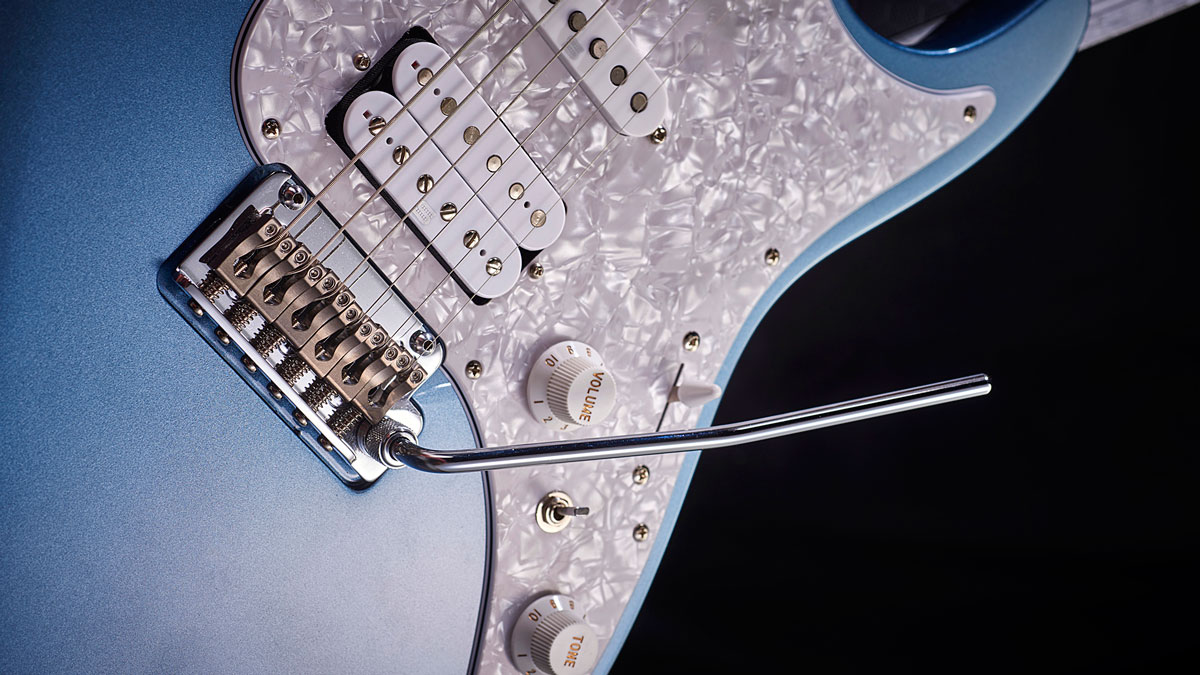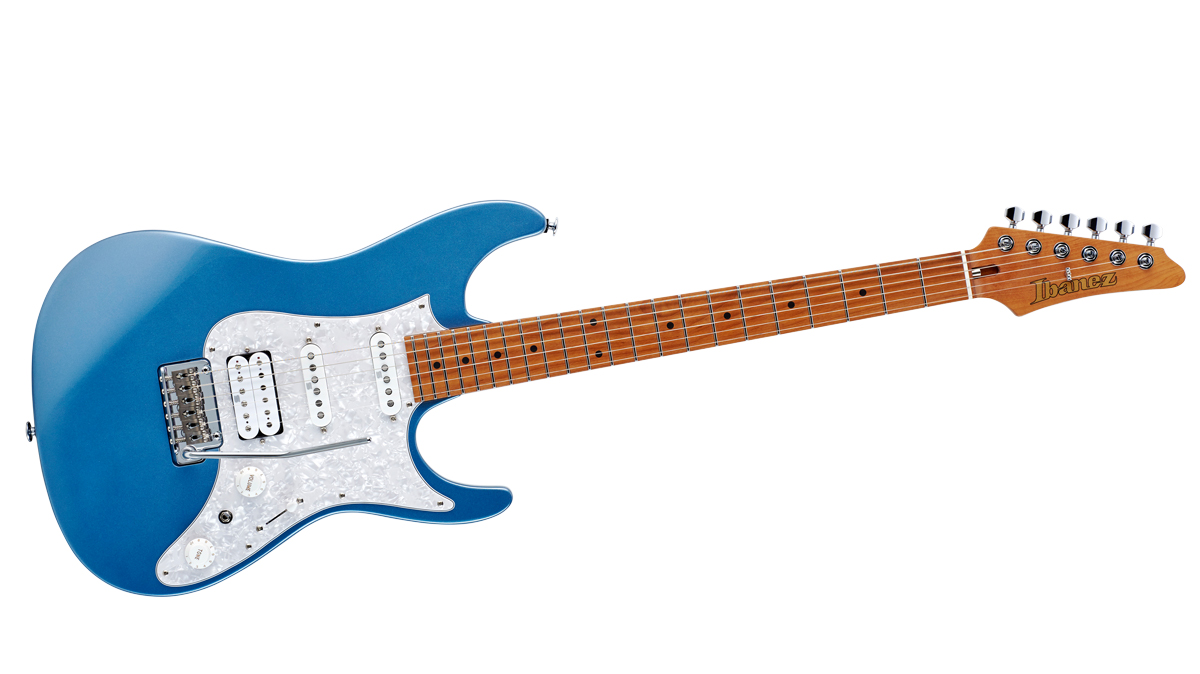MusicRadar Verdict
An immensely playable, versatile solidbody that can handle any genre you can throw at it.
Pros
- +
Good-looking, smart build, great playability, hugely versatile sounds. What’s not to like?
Cons
- -
Lack of colours, no lefties, rosewood fingerboard options.
MusicRadar's got your back
By design, the AZ series is all about function: a tool to do a job.
That said, both the body and neck adopt a more vintage bolt-on guise that’s less pointy, more classic than we’re used to from Ibanez. The body contour here, especially the rib-cage cut, is very deep and although the edge radius is pretty tight these are comfortable, familiar guitars.
All the recently-released AZs, as you’d expect, are based around the classic 648mm (25.5-inch) bolt-on scale length. There are both 22- and 24-fret models in both Prestige and Premium lines: the 22-fret models have an HSS pickup configuration and a Strat-meets-RG-style scratchplate; the 24-fret models have dual direct-mount humbuckers with no scratchplate and rear-mounted electronics. Bridge positions are the same on both 22/24-fret platforms, the 24-fret neck therefore sits slightly deeper into the body and as a result the treble cutaway is slightly deeper, too. Here, we’re looking at the Prestige AZ2204-ICM.
All use the same heavily rounded ‘All Access’ body heel with four recessed screws that sit into inset washers; the heel area is slightly thinner in depth than the rest of the body and both cutaways have quite considerable scooping on the back, not the front. High fret access is easy.
Roasted maple is becoming the neck wood of choice for those serious about their bolt-ons. The Prestige models use something called S-Tech wood - a patented torrefaction process created by Sendai Technologies in Japan that “decreases the density and improves the wood’s dimensional stability. It also gives the wood a more uniformly dark appearance”.
Nuts are oil-impregnated bone on this model, while position markers are black dots on the face which do lack a little contrast on the dark ’board but side dots are the modern must-have glow-in-the-dark types. Oh, and that headstock is far from pointy and employs a ‘vintage’ logo. It all helps to move the AZ away from Ibanez’s overly rock image.

Tuners are Gotoh’s SG381 with both height adjustable posts (HAP) and Magnum Locks. The former allow you set the post heights to maximize the string angle behind the nut although Ibanez still uses a string tree on the top two strings while the locking element self-locks as you wind on the string and unlocks - usually with a little help from a blade or coin in the top notched tip - as you unwind it. Once you get used to ’em they’re fine but both the locking element and setting the post heights can be, well, fiddly at first.
The vibrato bridge is based on Gotoh’s ‘modern classic’ 510 with two height adjustable and lockable pivot posts, plus a new-design knurled collar to tension the push-fit vibrato arm. The Prestige’s T1802 version uses nicely-shaped titanium saddles and a full steel block without deep drilled anchor holes.
Pickups and control
Having gone to so much detail it’s little surprise we have a completely new set of AZ-exclusive pickups: Seymour Duncan Hyperion designed collaboratively, we’re told, with Duncan’s Maricela ‘MJ’ Juarez. These Prestige HSS pickups are clearly marked as originating from Duncan’s Custom Shop.
This HSS guitar has the dyna-MIX 9 system introduced by a two-way mini-toggle ‘Alter’ switch placed between the master volume and tone controls. In position 1 (towards the tone control) we get the usual selections from the five-way: neck, neck and middle, middle, middle and slug coil of the bridge humbucker and, lastly, the full bridge humbucker. Flip the Alter switch towards the volume control, however, and we get four additional sounds: neck and middle in series, neck and screw coil of the bridge humbucker in parallel, neck and middle in series plus the bridge humbucker added in parallel, the slug coil of the bridge humbucker and, once again, the bridge humbucker.
This model also has conductive paint in the cavities. The volume controls have a treble bleed capacitor (330picofarad); the tone capacitor is 0.022microfarad. One final performance consideration is the placement of the output jack - on the guitar’s side, by the lower wide flange strap button, and angled so you thread your lead through your strap to secure it more easily.
This Prestige model clearly has an extra level of detail in comparison to the Premium models - from the fret-end finishing, slightly better fingerboard edge rounding, that nut material. It’s all about these details and then, of course, there’s the sound...
Feel and sounds
Ibanez’s RG might rightly be one of the relatively few modern classic designs but its thin-depthed, wide and flat neck isn’t for everyone, not least those of us that like more traditional bolt-ons. While the spec, for example, on the Super Wizard HP - “the neck for shredders,” states Ibanez - offers a 17mm depth at the first fret, 19mm by the 12th with a nut with of 43mm and a ’board radius of 430mm (16.9"), the AZ’s neck is much more conventional measuring between 41.84mm to 42.38mm at the nut, 20.5 to 21mm at the 1st fret and between 23mm and 23.2mm at the 12th.
The ’board radius is rounder too and puts the AZ much more in line with modern Fender or Suhr. Neck relief, as supplied, is minimal. The neck has an oil finish and will certainly need a little maintenance the more you play. A quick rub with a fine Scotch-Brite pad made them feel very satin-smooth.
The modern/vintage vibe certainly continues to the actual sound. The guitar does not have an overly resonant response: it’s quite firm but with oodles of zingy sustaining ring that’s a noticeable contrast to the woodier unplugged response of the more traditional vintage-y bolt-ons we have for comparison.
This AZ model might well surprise many players who’ve pigeon-holed Ibanez as shred guitars for the masses
Getting your head around the sound options takes a little practice. As we said, the ‘standard’ mode is with that two-way Alter switch pointing down towards the tone control and with the bridge humbuckers measuring around 14.8k ohms (the neck ’bucker measures approximately 9k ohms), the single coils just over 10k ohms, these
are far from vintage spec. The humbuckers impart a thick but not overly dark voice;
the single coils, despite that overwound reading, sound full but nicely contrasting and well-balanced in context.
A little time spent with the HSS Prestige reveals a beautiful hard rock platform that retains quite a woody, percussive bolt-on character while it certainly doesn’t wimp out in bridge position. As ever the single coils provide the more textural contrast and through a clean Fender amp voice, with a little volume reduction, produce more than credible Stratty funk rhythm, Texas Blues sizzle and a lot more.
Accessing the other four sounds, with the two-way switch pointing up towards the volume expands the core sounds (and retains the go-to bridge humbucker voice) with some reasonably complex series links and, in this mode, the only true single coil voice (the slug coil of the bridge humbucker). Any switching system like this is ultimately a compromise and the key lies in learning to navigate it.
About the only thing not covered here is a proper neck humbucking voice - it is an HSS, of course! But that said the neck and middle in series certainly goes in that direction with quite a wide and thick voice. No, it ain’t a classic PAF-alike but with a lot more gain there’s a vocal character that’s near perfect for your Beck-esque emotive instrumental leads. Switch to clean and it’ll get you through a more muted jazz/blues tune with absolutely no problem.
Hugely interesting, this AZ model might well surprise many players who’ve pigeon-holed Ibanez as shred guitars for the masses. It certainly does that with plenty of potential for Floyd Rose-style whammy tricks (without the hassle of locks) but the Prestige models in particular would get you through a more conservative covers gig, no problem.
In fact, with the expansive switching systems there are plenty of credible sounds for players never intending to hit the high-gain channel. If Ibanez had added a proper tap - perhaps via a pull/push switch on the tone - to pull down the heat of the ’buckers for a more vintage spec voice, they’d have created the near perfect hybrid.
But, as is, for the player wanting to cover virtually everything from jazz to shred, well, they’ve pretty much done it. This is a seriously versatile, good-sounding, tidily made instrument that deserves to put Ibanez squarely back into the mainstream.
Dave Burrluck is one of the world’s most experienced guitar journalists, who started writing back in the '80s for International Musician and Recording World, co-founded The Guitar Magazine and has been the Gear Reviews Editor of Guitarist magazine for the past two decades. Along the way, Dave has been the sole author of The PRS Guitar Book and The Player's Guide to Guitar Maintenance as well as contributing to numerous other books on the electric guitar. Dave is an active gigging and recording musician and still finds time to make, repair and mod guitars, not least for Guitarist’s The Mod Squad.
With its latest free update, Ableton has finally turned Note into the app I always wanted it to be
Technically capable, but struggle to make your tunes sound musical? 5 simple music theory hacks to make your tracks stand out
"Despite its size, it delivers impressive audio quality and premium functions as well as featuring a good selection of inspired sounds": Roland GO:Piano 88PX review











